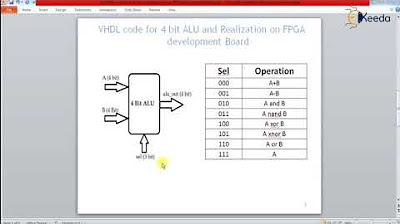STM32F4 Programming in C 1- LED Blinky coding in Keil using STM32CubeMx
Summary
TLDRIn this tutorial, Laki Kari guides viewers through the process of generating C code for LED blinking using the STM32F4 Discovery board with STM32 CubeMX. He walks through creating a new project, configuring GPIO pins, and initializing the board's settings, including clock configuration and pin assignment. The tutorial emphasizes preserving custom code by adding it between designated comment lines and demonstrates compiling and uploading the code to the microcontroller. After a successful upload, viewers see the LED blink, with a promise of future tutorials on interfacing GPIO pins for frequency toggling.
Takeaways
- 🔧 A new project can be created in STM32CubeMX by selecting the STM32F407 Discovery board.
- 📊 The STM32F4 Discovery board features an ARM Cortex-M4 MCU, onboard ST-Link version 2, and various peripherals.
- 💡 GPIO pins can be configured for LED control, with specific pins highlighted for input or output functionality.
- ⚙️ The maximum clock frequency for the board can be set to 168 MHz to enhance performance.
- 💻 Code generation in STM32CubeMX involves specifying project names, toolchain versions, and folder locations.
- 📝 Code for LED blinking is added between designated user code sections to ensure it is preserved upon regeneration.
- 🔄 The function HAL_GPIO_TogglePin is used to toggle the GPIO pin connected to the LED.
- ⏳ A delay function, HAL_Delay, is introduced to control the blinking rate of the LED.
- ✅ Compiling the code generates the necessary binary files, with the first compilation taking longer than subsequent builds.
- 🔄 After uploading the code to the microcontroller, pressing the reset button starts the LED blinking sequence.
Q & A
What is the purpose of the tutorial?
-The tutorial aims to demonstrate how to generate C code for an LED blinking program using the STM32F4 Discovery board.
Which microcontroller series is used in the STM32F4 Discovery board?
-The STM32F4 Discovery board uses the Cortex-M4 microcontroller series with a floating-point unit (FPU).
What are the key features of the STM32F4 Discovery board mentioned in the tutorial?
-Key features include ST-Link version 2, high-speed USB On-The-Go, and various peripherals such as an accelerometer and a graphic LCD interface.
How many user LEDs are available on the STM32F4 Discovery board?
-There are four user LEDs available on the STM32F4 Discovery board.
Which GPIO pin is selected for blinking the LED in the tutorial?
-The GPIO pin selected for blinking the LED is PD15.
What is the maximum clock frequency configured for the STM32F4 Discovery board?
-The maximum clock frequency configured is 168 MHz.
Why is it important to write user code between the specified comment lines in the main file?
-Writing user code between the specified comment lines ensures that the code will not be lost when regenerating the project files.
What delay is added for the LED blinking, and how does it affect the blink rate?
-A 50-millisecond delay is added, which results in the LED blinking twice per second.
What should be done after uploading the code to the microcontroller?
-After uploading the code, the reset button on the board should be pressed to start the LED blinking.
What can users expect in the next tutorial according to the transcript?
-In the next tutorial, users will learn how to interface GPIO pins with the LED and change its toggle frequency.
Outlines

このセクションは有料ユーザー限定です。 アクセスするには、アップグレードをお願いします。
今すぐアップグレードMindmap

このセクションは有料ユーザー限定です。 アクセスするには、アップグレードをお願いします。
今すぐアップグレードKeywords

このセクションは有料ユーザー限定です。 アクセスするには、アップグレードをお願いします。
今すぐアップグレードHighlights

このセクションは有料ユーザー限定です。 アクセスするには、アップグレードをお願いします。
今すぐアップグレードTranscripts

このセクションは有料ユーザー限定です。 アクセスするには、アップグレードをお願いします。
今すぐアップグレード5.0 / 5 (0 votes)






